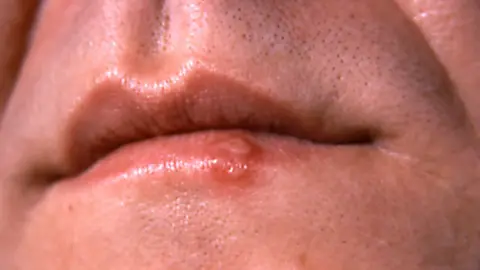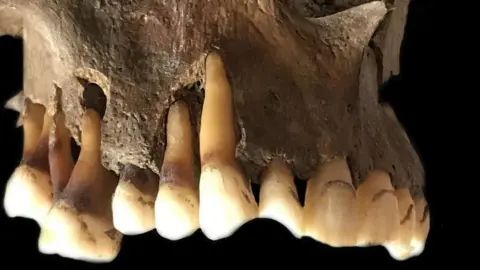Cold sores traced back to kissing in Bronze Age by Cambridge research
 Getty Images
Getty ImagesThe spread of cold sores could be traced back to kissing in the Bronze Age, a study found.
Scientists at the University of Cambridge said the HSV-1 strain of the herpes virus arose during vast migrations of people from Eurasia to Europe about 5,000 years ago.
The virus currently infects about 3.7 billion people worldwide.
Researchers have been studying DNA samples from thousands of years ago to understand how viruses adapt.
The migration led to denser populations, which increased transmission, and new cultural practices including kissing, the study found.
 University of Cambridge
University of CambridgeThe research team said it had become the first to uncover and sequence ancient genomes of the virus,
Previously, genetic data for herpes only went back to 1925, but the researchers discovered four samples from human remains dating over a 1,000-year period.
From the samples the team was able to develop an estimated timeline of the virus' evolution.
Researchers took the samples used in the study by extracting viral DNA from the roots of the teeth of four individuals.
 University of Cambridge
University of CambridgeFacial herpes is spread orally, and researchers said the earliest known record of kissing was from a Bronze Age manuscript from South Asia.
Centuries later, the Roman Emperor Tiberius tried to ban kissing at official functions to prevent disease spread, and researchers believed this may have been herpes-related.
Dr Christiana Scheib, research fellow at St John's College, Cambridge, and head of the ancient DNA lab at Tartu University, said: "Every primate species has a form of herpes, so we assume it has been with us since our own species left Africa.
"However, something happened around 5,000 years ago that allowed one strain of herpes to overtake all others, possibly an increase in transmissions, which could have been linked to kissing."

Find BBC News: East of England on Facebook, Instagram and Twitter. If you have a story suggestion email [email protected]
